Band decoder for Arduino
← Web page | HamShop.cz version →
This version is obsolete.
The hardware
- Schematics
- PCB
Front side

- 1-14 - green LED signalizing relay status.
- 15-16 - not used outputs.
- white square - sign defines the type of equipment.
Back side

- DATA - RJ45 input data connector for Band decoder
- - TXD (UART/232 dependency internal switch).
- - GND.
- - RXD (UART/232 dependency internal switch).
- - BCD-1 input.
- - BCD-2 input.
- - A/D input.
- - BCD-3 input.
- - BCD-4 input.
- USB - +5V DC POWER supply, or upload arduino firmware.
- ETHERNET - not used.
- OUTPUTS - 14 relay outputs and GND.

How to connect Power
- plug power via usb mini cable to AC adapter, computer or usb HUB
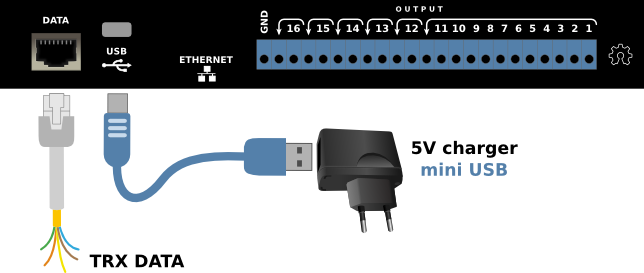
Configure inputs
uncomment and activate only one input in source code
//=====[ Inputs ]============================================================================================= // #define INPUT_SERIAL // telnet ascii input - cvs format [band],[freq]\n (serial.h) // #define ICOM_CIV // read frequency from CIV (icom_civ.h) ** you must enabled 'CI-V transceive' in TRX settings, and disable ICOM_CIV_OUT ** // #define KENWOOD_PC // RS232 CAT (kenwood_pc.h) // #define YAESU_BCD // TTL BCD in A (yaesu_bcd.h) // #define ICOM_ACC // voltage 0-8V on pin4 ACC(2) connector - need calibrate in (icom_acc.h)And connect to TRX as described below
Available Inputs
Input Serial
Activate uncomment line
#define INPUT_SERIAL
Not need any hardware settings, only send via USB to serial line ascii characters in preconfigured baudrate.
X,YYYYYYY\n
- X - band output in range 0-14, if activate BCD output range is 0-10 because 11-14 reserved for BCD. 0 (zero) = no output will be turned on.
- YYYYYYY - frequency in Hz - has no effect on the output relays, used if any CIV/CAT outputs activated.
- \n - is LF Line Feed (0A in hex)
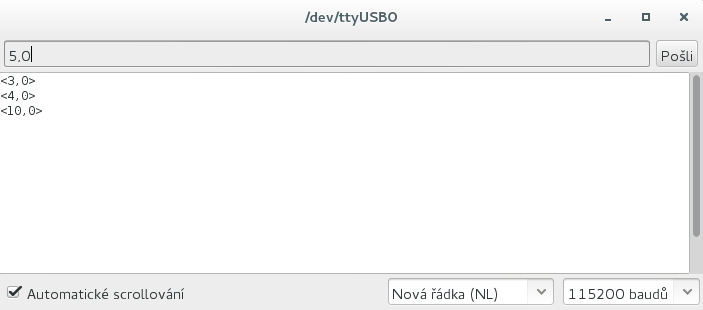
ICOM CIV
Input works in sniff mode (data over one wire - RXD). This means that it is necessary to provide, transmit frequency of TRX to serial line
- enabled CI-V transceive in TRX menu settings
- comunicate with TRX by other device or software (for example logbook with CAT support)
Activate uncomment line
#define ICOM_CIV
Requires baud rate and CIV address in setting section of source code
#define SERBAUD 9600 // [baud] Serial port in/out baudrate #define CIV_ADRESS 0x56 // HEX Icom adress (0x is prefix)
Deactivate watchdog and request
// #define WATCHDOG 10 // [sec] determines the time, after which the all relays go OFF, if missing next input data - uncomment for the enabled // #define REQUEST // use TXD output for sending frequency request (Kenwood PC, Yaesu CAT, Yaesu CAT old, Icom CIV)
In icom_civ.h file you can set rules to select individual output relays, with a resolution of one Hz.
//=====[ Frequency (Hz) to Band rules ]======================================
// you can expand rules up to 14 Bands
if (freq >= 1810000 && freq <= 2000000 ) {BAND=1;} // 160m
else if (freq >= 3500000 && freq <= 3800000 ) {BAND=2;} // 80m
else if (freq >= 7000000 && freq <= 7200000 ) {BAND=3;} // 40m
else if (freq >= 10100000 && freq <= 10150000 ) {BAND=4;} // 30m
else if (freq >= 14000000 && freq <= 14350000 ) {BAND=5;} // 20m
else if (freq >= 18068000 && freq <= 18168000 ) {BAND=6;} // 17m
else if (freq >= 21000000 && freq <= 21450000 ) {BAND=7;} // 15m
else if (freq >= 24890000 && freq <= 24990000 ) {BAND=8;} // 12m
else if (freq >= 28000000 && freq <= 29700000 ) {BAND=9;} // 10m
else if (freq >= 50000000 && freq <= 52000000 ) {BAND=10;} // 6m
else if (freq >= 144000000 && freq <= 146000000 ) {BAND=11;} // 2m
else {BAND=0;} // out of range
//===========================================================================
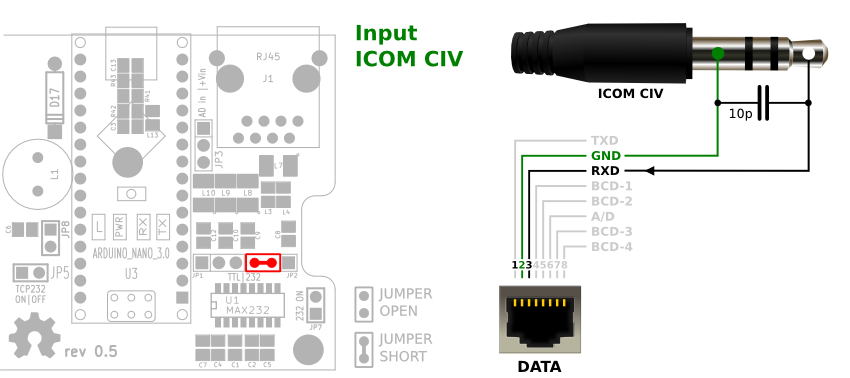
- short JP2 left (RXD)
KENWOOD CAT
Input works in sniff mode (data over one wire - RXD). This means that it is necessary to provide, transmit frequency of TRX to serial line
- comunicate TRX with other device or software (for example logbook with CAT support)
- activate function Frequency request which utilizes data output TXD, and prevent the use of any from CAT/CIV output.
Activate uncomment line
#define KENWOOD_PC
Requires baud rate in setting section of source code
#define SERBAUD 9600 // [baud] Serial port in/out baudrate // #define WATCHDOG 10 // [sec] determines the time, after which the all relays go OFF, if missing next input data - uncomment for the enabled // #define REQUEST // use TXD output for sending frequency request (Kenwood PC)
You can also use functions
- WATCHDOG - determines the time, after which the all relay OFF, if missed next input data
- REQUEST - use TXD output for sending frequency request - and prevent the use of any from CAT/CIV output.
In kenwood_pc.h file you can set rules to select individual output relays, with a resolution of one Hz.
//=====[ Frequency (Hz) to Band rules ]======================================
// you can expand rules up to 14 Bands
if (freq >= 1810000 && freq <= 2000000 ) {BAND=1;} // 160m
else if (freq >= 3500000 && freq <= 3800000 ) {BAND=2;} // 80m
else if (freq >= 7000000 && freq <= 7200000 ) {BAND=3;} // 40m
else if (freq >= 10100000 && freq <= 10150000 ) {BAND=4;} // 30m
else if (freq >= 14000000 && freq <= 14350000 ) {BAND=5;} // 20m
else if (freq >= 18068000 && freq <= 18168000 ) {BAND=6;} // 17m
else if (freq >= 21000000 && freq <= 21450000 ) {BAND=7;} // 15m
else if (freq >= 24890000 && freq <= 24990000 ) {BAND=8;} // 12m
else if (freq >= 28000000 && freq <= 29700000 ) {BAND=9;} // 10m
else if (freq >= 50000000 && freq <= 52000000 ) {BAND=10;} // 6m
else if (freq >= 144000000 && freq <= 146000000 ) {BAND=11;} // 2m
else {BAND=0;} // out of range
//===========================================================================

- short JP2 right (RXD)
- short JP7 (PWR max232)

- short JP2 right (RXD)
- short JP1 right (TXD)
- short JP7 (PWR max232)
KENWOOD TS-x50 CAT
This small PCB inverted TTL signal for old Kenwood RTX.
- compatibile with Band decoder rev. 0.6 or higher
- no more jumper needs
- only plug small add-on to master pcb
- connections to radio by DATA RJ45 connector
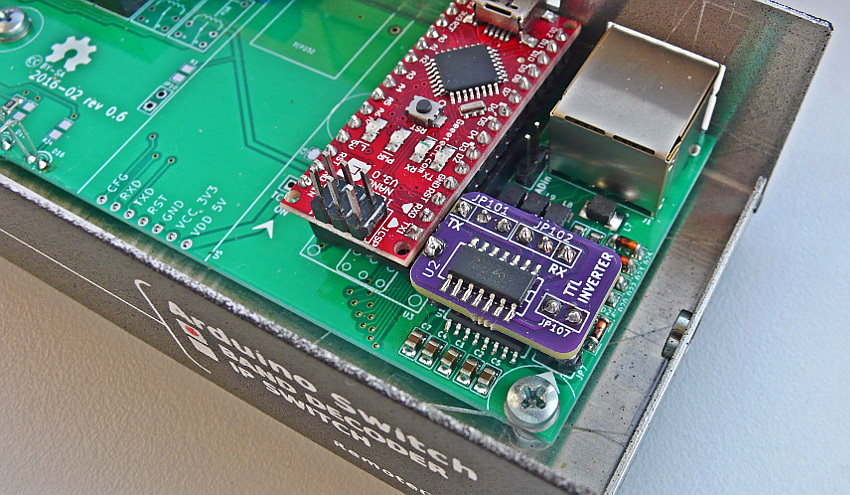
YAESU CAT
Input worked in sniff mode (data over one wire - RXD). This means that it is necessary to provide, transmit frequency of TRX to serial line
- comunicate TRX with other device or software (for example logbook with CAT support)
- activate function Frequency request which utilizes data output TXD, and prevent the use of any from CAT/CIV output.
Activate uncomment line
#define YAESU_CAT
Requires baud rate in setting section of source code
#define SERBAUD 9600 // [baud] Serial port in/out baudrate // #define WATCHDOG 10 // [sec] determines the time, after which the all relay OFF, if missed next input data - uncomment for the enabled // #define REQUEST // use TXD output for sending frequency request (Kenwood PC, Yaesu CAT)
You can also use functions
- WATCHDOG - determines the time, after which the all relay OFF, if missed next input data
- REQUEST - use TXD output for sending frequency request - and prevent the use of any from CAT/CIV output.
In yaesu_cat.h file you can set rules to select individual output relays, with a resolution of one Hz.
//=====[ Frequency (Hz) to Band rules ]======================================
// you can expand rules up to 14 Bands
if (freq >= 1810000 && freq <= 2000000 ) {BAND=1;} // 160m
else if (freq >= 3500000 && freq <= 3800000 ) {BAND=2;} // 80m
else if (freq >= 7000000 && freq <= 7200000 ) {BAND=3;} // 40m
else if (freq >= 10100000 && freq <= 10150000 ) {BAND=4;} // 30m
else if (freq >= 14000000 && freq <= 14350000 ) {BAND=5;} // 20m
else if (freq >= 18068000 && freq <= 18168000 ) {BAND=6;} // 17m
else if (freq >= 21000000 && freq <= 21450000 ) {BAND=7;} // 15m
else if (freq >= 24890000 && freq <= 24990000 ) {BAND=8;} // 12m
else if (freq >= 28000000 && freq <= 29700000 ) {BAND=9;} // 10m
else if (freq >= 50000000 && freq <= 52000000 ) {BAND=10;} // 6m
else {BAND=0;} // out of range
//===========================================================================
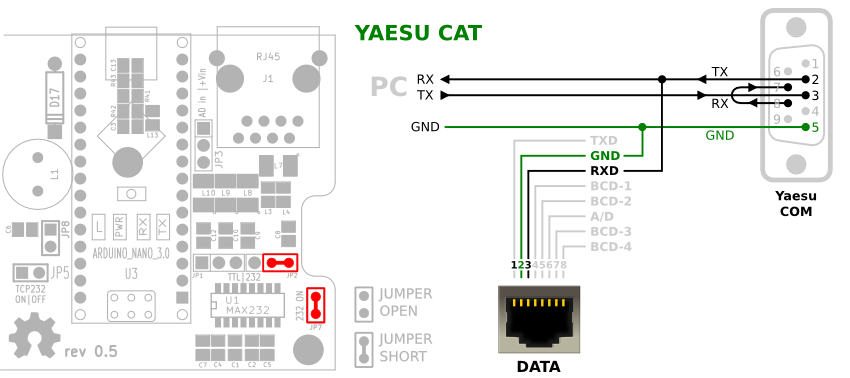
- short JP2 right (RXD)
- short JP7 (PWR max232)

- short JP2 right (RXD)
- short JP1 right (TXD)
- short JP7 (PWR max232)
YAESU BCD
Activate uncomment line
#define YAESU_BCD
In yaesu_bcd.h file you can set rules to select individual output relays, dependency to BCD input.
=======[ Input BCD ]====================================================================
BCD 1 --> */ { 0, 1, 0, 1, 0, 1, 0, 1, 0, 1, 0, 1, 0, 1, 0 }, /*
BCD 2 --> */ { 0, 0, 1, 1, 0, 0, 1, 1, 0, 0, 1, 1, 0, 0, 1 }, /*
BCD 3 --> */ { 0, 0, 0, 0, 1, 1, 1, 1, 0, 0, 0, 0, 1, 1, 1 }, /*
BCD 4 --> */ { 0, 0, 0, 0, 0, 0, 0, 0, 1, 1, 1, 1, 1, 1, 1 }, /*
| | | | | | | | | | | | | | |
V V V V V V V V V V V V V V V
-------------------------------------------------------------------------------------
Band # in matrix table 0 1 2 3 4 5 6 7 8 9 10 11 12 13 14
Yaesu BCD 160 80 40 30 20 17 15 12 10 6m <--- free --->
-------------------------------------------------------------------------------------
========================================================================================
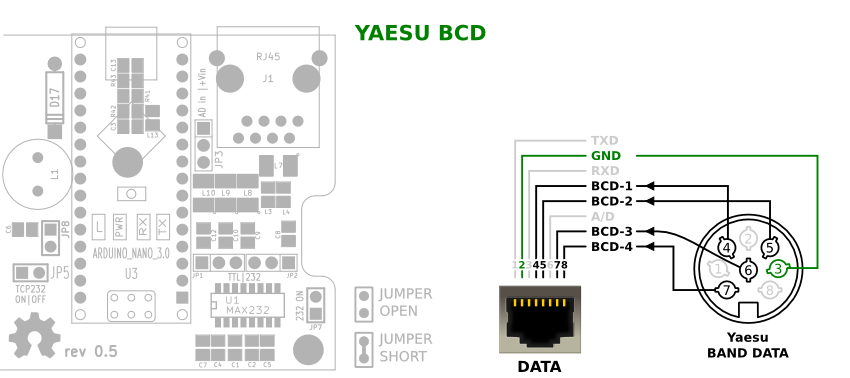
ICOM ACC(2) voltage
Activate uncomment line
#define ICOM_ACC
In icom_acc.h file you can set voltage range rules to select individual output relays.
//=====[ Icom ACC voltage range ]===========================================================
if (VOLTAGE > 0.73 && VOLTAGE < 1.00 ) {BAND=10;} // 6m * * * * * * * * * * * * * * * *
if (VOLTAGE > 1.00 && VOLTAGE < 1.09 ) {BAND=9;} // 10m * Need *
if (VOLTAGE > 1.09 && VOLTAGE < 1.32 ) {BAND=8;} // 12m * calibrated to your *
if (VOLTAGE > 1.32 && VOLTAGE < 1.55 ) {BAND=7;} // 15m * own ICOM *
if (VOLTAGE > 1.55 && VOLTAGE < 1.77 ) {BAND=6;} // 17m * ---------------- *
if (VOLTAGE > 1.77 && VOLTAGE < 2.24 ) {BAND=5;} // 20m * (These values have *
if (VOLTAGE > 0.10 && VOLTAGE < 0.50 ) {BAND=4;} // 30m * been measured by any) *
if (VOLTAGE > 2.24 && VOLTAGE < 2.73 ) {BAND=3;} // 40m * ic-746 *
if (VOLTAGE > 2.73 && VOLTAGE < 2.99 ) {BAND=2;} // 80m * *
if (VOLTAGE > 2.99 && VOLTAGE < 4.00 ) {BAND=1;} // 160m * * * * * * * * * * * * * * * *
if (VOLTAGE > 0.00 && VOLTAGE < 0.10 ) {BAND=0;} // parking
//==========================================================================================
When calibrating can read the measured voltage in the terminal, enable the echo function and set serial baudrate
#define SERIAL_echo #define SERBAUD 9600
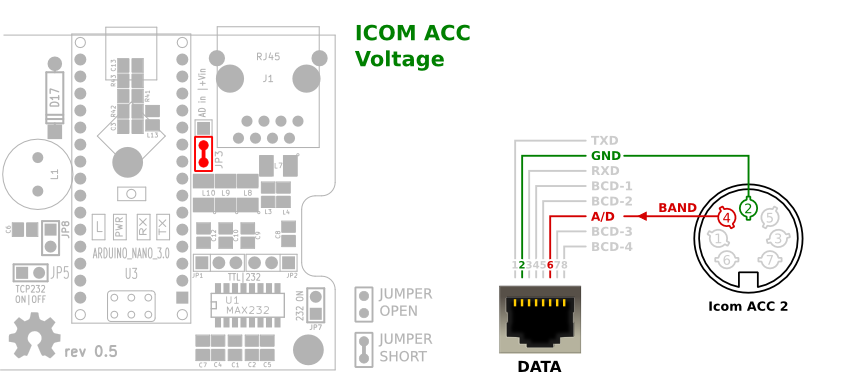
- short JP3
Configure outputs
You can uncomment more than one output, but not all combinations are possible. See on Context table and description of parts.
Always usable - may all at once.
- 14 Relay - allways enabled (with enable BCD output, 10 relay)
- Serial echo
- Yaesu BCD
Only one from (not available during active Frequency request option (available only one TXD line)
//=====[ Outputs ]============================================================================================ // #define REMOTE_RELAY // TCP/IP remote relay - need install and configure TCP232 module // #define SERIAL_echo // Feedback on serial line in same baudrate, CVS format <[band],[freq]>\n // #define ICOM_CIV_OUT // send frequency to CIV ** you must set TRX CIV_ADRESS, and disable ICOM_CIV ** // #define KENWOOD_PC_OUT // send frequency to RS232 CAT ** for operation must disable KENWOOD_PC and REQUEST ** // #define BCD_OUT // output 11-14 relay used as Yaesu BCD
External remote 14 IP Relay
Need two device with TCP232 ethernet module included
- IP Band decoder
- IP Relay
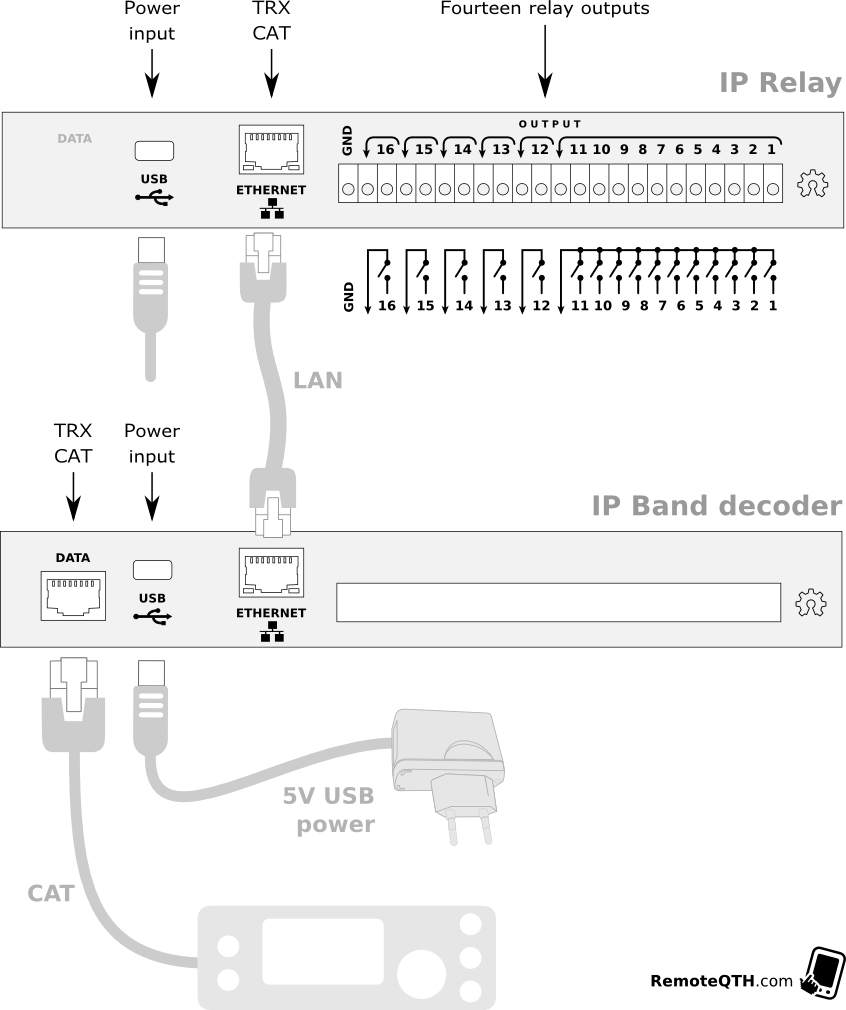
- IP Band decoder use arduino firmware rev 0.4 or higher → for band decoder:
- Remove all jumpers.
- Configure Inputs → dependancy to your trx.
- If band decoder work with you TRX well, activate transceive data with uncomment line
#define REMOTE_RELAY // TCP/IP remote relay - need install and configure TCP232 module
(enable other outputs is not recommended), and upload new firmware (before upload remove all jumpers - after return back). - Enable IP module with short jumper JP5.
- IP Relay - use different arduino firmware for IP relay → band-decoder-0x-rel
- Remove jumper JP5.
- configure three settings
#define delayR 10 // sec [Relay] determines the time, after which the relay parking #define parking 14 // out [Relay] 1-14 parking output after timeout - optimally for grounded antenna int baud = 9600;
baudrate must be same as TRX. - Upload firmware.
- Return back jumper JP5.
- Both devices
- Configure Network → baudrate must be same as TRX.
- NOTE: all baudrate must be same
- TRX
- Arduino firmware (band decoder)
- IP module in band decoder
- Arduino firmware (IP relay)
- IP module in IP relay
14 RELAYS
- Allways enabled.
An entrance band data, or frequency, converts to output band 0-14 which can be configured in the following table - Preset Band to output matrix - in default settings Band-1 corresponds to Relay-1, etc. You can sets any combination outputs for each band separately. With change zeros and ones in the Matrix table. Band-0 reserved for out of range inputs measure.
//=====[ Sets band --> to output in MATRIX table ]===========================================================
boolean matrix[15][15] = { /*
Band 0 --> */ { 0, 0, 0, 0, 0, 0, 0, 0, 0, 0, 0, 0, 0, 0, 0 }, /* if inputs out of range
\ Band 1 --> */ { 1, 0, 0, 0, 0, 0, 0, 0, 0, 0, 0, 0, 0, 0, 0 }, /*
\ Band 2 --> */ { 0, 1, 0, 0, 0, 0, 0, 0, 0, 0, 0, 0, 0, 0, 0 }, /*
\ Band 3 --> */ { 0, 0, 1, 0, 0, 0, 0, 0, 0, 0, 0, 0, 0, 0, 0 }, /*
\ Band 4 --> */ { 0, 0, 0, 1, 0, 0, 0, 0, 0, 0, 0, 0, 0, 0, 0 }, /*
\ Band 5 --> */ { 0, 0, 0, 0, 1, 0, 0, 0, 0, 0, 0, 0, 0, 0, 0 }, /*
\ Band 6 --> */ { 0, 0, 0, 0, 0, 1, 0, 0, 0, 0, 0, 0, 0, 0, 0 }, /*
IN ) Band 7 --> */ { 0, 0, 0, 0, 0, 0, 1, 0, 0, 0, 0, 0, 0, 0, 0 }, /*
/ Band 8 --> */ { 0, 0, 0, 0, 0, 0, 0, 1, 0, 0, 0, 0, 0, 0, 0 }, /*
/ Band 9 --> */ { 0, 0, 0, 0, 0, 0, 0, 0, 1, 0, 0, 0, 0, 0, 0 }, /*
/ Band 10 -> */ { 0, 0, 0, 0, 0, 0, 0, 0, 0, 1, 0, 0, 0, 0, 0 }, /*
/ Band 11 -> */ { 0, 0, 0, 0, 0, 0, 0, 0, 0, 0, 1, 0, 0, 0, 0 }, /*
/ Band 12 -> */ { 0, 0, 0, 0, 0, 0, 0, 0, 0, 0, 0, 1, 0, 0, 0 }, /*
/ Band 13 -> */ { 0, 0, 0, 0, 0, 0, 0, 0, 0, 0, 0, 0, 1, 0, 0 }, /*
Band 14 -> */ { 0, 0, 0, 0, 0, 0, 0, 0, 0, 0, 0, 0, 0, 1, 0 }, /*
| | | | | | | | | | | | | |
V V V V V V V V V V V V V V
-----------------------------------------------------------
| 1 2 3 4 5 6 7 8 9 10 11 12 13 14 |
-----------------------------------------------------------
OUTPUTS RELAY*/
};
//============================================================================================================
Note: if enable BCD output function, relay 11-14 reserved for BCD.
SERIAL ECHO
Activate uncomment line
#define SERIAL_echo
Requires setting
#define SERBAUD 9600
YAESU BCD output
Activate uncomment line
#define BCD_OUT
This option will reduce the number of relays at 10. Relay 11-14 used for BCD.
In band-decoder.ino file you can set rules to select BCD output, dependency to detected band input.
//=====[ Output BCD ]==========================================================================
#if defined(BCD_OUT)
void bcdOut(){
boolean BCDmatrixOUT[4][11] = { /*
--------------------------------------------------------------------
Band # to output relay 0 1 2 3 4 5 6 7 8 9 10
(Yaesu BCD) 160 80 40 30 20 17 15 12 10 6m
--------------------------------------------------------------------
| | | | | | | | | | |
V V V V V V V V V V V
*/ { 0, 1, 0, 1, 0, 1, 0, 1, 0, 1, 0 }, /* --> Relay 11
*/ { 0, 0, 1, 1, 0, 0, 1, 1, 0, 0, 1 }, /* --> Relay 12
*/ { 0, 0, 0, 0, 1, 1, 1, 1, 0, 0, 0 }, /* --> Relay 13
*/ { 0, 0, 0, 0, 0, 0, 0, 0, 1, 1, 1 }, /* --> Relay 14
ICOM CIV output
Activate uncomment line
#define ICOM_CIV_OUT
Requires baud rate and CIV address in setting section of source code
#define SERBAUD 9600 // [baud] Serial port in/out baudrate #define CIV_ADR_OUT 0x56 // HEX Icom adress (0x is prefix)

- short JP1 left (TXD)
KENWOOD CAT output
Activate uncomment line
#define KENWOOD_PC_OUT
Requires baud rate in setting section of source code
#define SERBAUD 9600 // [baud] Serial port in/out baudrate

- short JP1 right (TXD)
- short JP7
YAESU CAT output
Activate uncomment line
#define YAESU_CAT_OUT
Requires baud rate in setting section of source code
#define SERBAUD 9600 // [baud] Serial port in/out baudrate
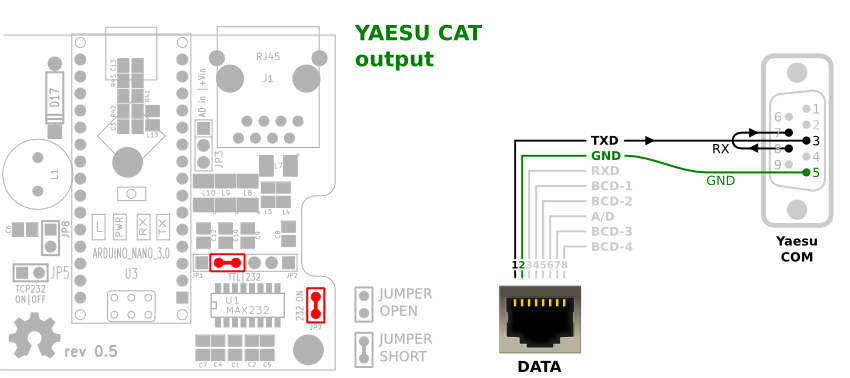
- short JP1 right (TXD)
- short JP7
Upload Firmware
Band decoder settup is performed via firmware source code. It is compile and upload to device with Arduino GUI.
- For beginners Getting Started with Arduino.
- Download source code and configuring it.
- Before uploading new firmware you have to
- remove top cover - loosening the two screws on left and right side of the box.
- remove JP1, JP2 and JP7 jumpers
- Select menu
- Tools/Board/Arduino nano
- Tools/Procesor/ATmega328
- Tools/Port/<your port>
- Upload
- After upload set back jumpers dependency to setup.
Have a fun!